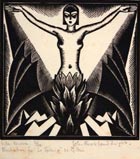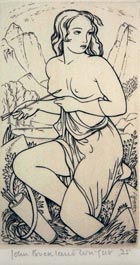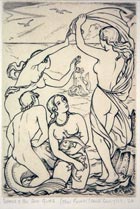Cabinet 05
 |
The fourteen wood engravings in Iwan Gilkin's Le Sphinx are of particular importance because they represent JBW's first book illustrations. They were created in 1928, well before his engravings for Keats's Sonnets (1930), but not published in their entirety until issued as a gift to members of Graphia in 1960. Illustration from Iwan Gilkin, Le Sphinx. Antwerp: Graphia, 1928. Dunedin Public Art Gallery. No. 125-1970. |
 |
By the early 1930's, JBW's reputation as an artist was well-known, especially in European circles. Although commissioned work continued to arrive, he explored self-publishing, as a way in which he could remain in control of both subject and treatment. Cupid's Pastime was produced as a limited edition of 31 copies in 1935 under the imprint of 'J.B.W. Editions.' A note in the colophon reads: 'a private experiment in illustration and typography by the engraver of the plates, who offers no other excuse for this publication.' There is a timeless quality to what is an exquisitely executed engraving. 'Girl or Nymph with arrow', in Cupid's Pastime. Printed by A. A. M. Stols for J.B.W., 1935. Dunedin Public Art Gallery. No. 108-1993. |
 |
The second 'J.B.W.' publication was The Marriage of Cupid and Psyches [sic], which appeared in 1936. In a colophon note not used, JBW stated that the engravings were printed by himself using a special ink made from a recipe of Joseph Hecht's which was itself based on fifteenth century formulas. The war put an end to any further 'JBW' experiments. 'Venus summoning the sea-gods' is one of ten copper engravings in the book. 'Venus summoning the sea-gods' from The Most Pleasant and Delectable Tale of the Marriage of Cupid and Psyches [sic]. Printed by J. Enschedé en Zonen, Haarlem, for J.B.W. Editions, 1936. Dunedin Public Art Gallery. No. 120-1993. |
| «Previous | Next» |
